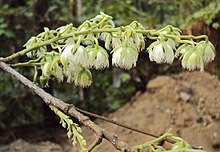| Elaeocarpus serratus | |
|---|---|

| |
| Scientific classification | |
| Kingdom: | Plantae |
| Clade: | Tracheophytes |
| Clade: | Angiosperms |
| Clade: | Eudicots |
| Clade: | Rosids |
| Order: | Oxalidales |
| Family: | Elaeocarpaceae |
| Genus: | Elaeocarpus |
| Species: | E. serratus
|
| Binomial name | |
| Elaeocarpus serratus | |
| Varieties[1] | |
|
Elaeocarpus serratus var. weibelii Zmarzty | |
| Synonyms[2] | |
| |




Elaeocarpus serratus, the Ceylon olive, is a tropical flowering plant in the family Elaeocarpaceae. It is a medium to large tree, with white flowers. It has a disjunctive distribution, with the species occurring in Sri Lanka and southern India, and in Assam, Bangladesh and other parts in the north of the Indian subcontinent. The fruit is commonly eaten, and people also use the plant for ornamental, religious and folk-medicinal purposes. There are historical records of traditional-medicine use of the plant. Paradoxurus jerdoni (Brown palm civet) consumes parts of the tree.
- ^ "Elaeocarpus serratus var. weibelii Zmarzty". Plants of the World Online. Royal Botanic Gardens, Kew. Retrieved 11 May 2021.
- ^ "Elaeocarpus serratus L." Plants of the World Online. Royal Botanic Gardens, Kew. Retrieved 11 May 2021.